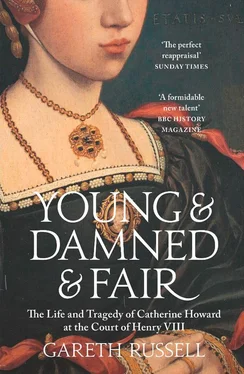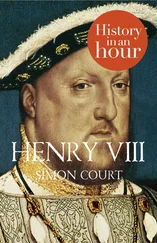Riots were rare in Henrician England, but tensions were constant and none were more intense than those caused by the country’s break with Rome. Seven years before Cromwell’s execution, the king had repudiated papal authority and embarked upon his own version of the Reformation in what rapidly became one of the least articulate government policies in British history. There was absolutely no clear strategy for where the Church of England should go once it was commanded from London rather than Rome. The king, who had harnessed anti-clericalism in Parliament to secure his dream of annulling his marriage to Katherine of Aragon, had then hurled himself into what initially looked like the wholesale dismemberment of English Catholicism. The severing of obedience to the Vatican was the initial step in a legal, cultural, and economic revolution. The monasteries were dissolved, or pressured to surrender, first the smaller abbeys, then the larger and wealthier. On the eve of the Reformation, about one-third of the land in England belonged to the Church and so the seizure of its assets became an unsavoury bonanza for the government and its supporters, whose loyalty to the regime was often bought with gifts of land taken from the religious orders.
The first human casualties after the break with Rome had been the conservatives who could not in good conscience abjure their oaths of loyalty to the pope. There were some among them who, despite their misgivings, were prepared to acknowledge that canon law just about permitted the king’s banishment of Katherine of Aragon and marriage to Anne Boleyn, whom even Thomas More had acknowledged as ‘this noble woman royally anointed queen’, but under no circumstances could they accept that Henry had the right to make himself Supreme Head on Earth of the Church of England and Ireland.13 Thomas More, the country’s former Lord Chancellor, and the esteemed scholar Cardinal John Fisher went to the block in 1535. The leaders of the Carthusian order of monks were hanged until they were half dead, cut down to be castrated, disembowelled and only then beheaded. The country folk coming into London through Newgate for Cromwell’s death had to pass by the looming, grey-stoned edifice of Newgate prison, where three hermits, one deacon and six monks had been stripped, chained to posts with their hands tied behind their backs and simply left to starve to death in their cells, rotting towards martyrdom in excruciating pain and their own gathering excrement. One plucky Catholic lady, a doctor’s wife, disguised herself as a milk maid, bribed the guards to let her into the cell and fed, watered and bathed the condemned gentlemen. The gaolers tightened security after the king irritably asked how the condemned men had remained alive for so long.14
A few miles to the west of the prison was Tyburn, the site of near-daily executions of criminals – rapists, horse thieves, forgers and murderers. It was here that many of the Carthusian monks met their end after being processed through the streets tied to a wicker hurdle pulled by a slow-moving horse. Back at Smithfield, within sight of the grubby walkways of Cock Lane, Father John Forest had been burned to death atop a pyre that consisted of religious statues, including one of Saint Derfel, taken from a pilgrimage centre in north Wales. There was a hideous poetic irony in using the symbols of pre-Reformation Christianity to incinerate one of its most vocal sympathisers.
For the poorest of the poor, the Reformation initially brought a different kind of martyrdom. Admittedly, the Church had not always done all that it could to alleviate poverty, but as medieval Catholicism’s emphasis on charity as a means to secure salvation came under attack by reformers, beggars would have been a depressingly and increasingly familiar sight for the spectators. This was especially true for those from Smithfield whose monastic hospital and poorhouse, St Bartholomew’s Priory, had been shut down during the dissolutions, leaving the local poor and invalided defenceless, friendless and often homeless. Throughout London it was the same, with those who had relied on the Church either for charity or work, wandering the streets, joined by the hundreds who poured in from the countryside where the dissolutions had closed off many traditional forms of employment or benefice. Nor were the seized properties being put to edifying use in the post-monastic world. Courtiers, lawyers and merchants who benefited from the government’s liberality often turned the former abbeys and churches into stinking tenements, overpacked and overpriced, where families lived in pathetically cramped quarters with rampant disease and indifferent landlords. The church of St Martin-le-Grand was demolished to make way for a tavern; Bermondsey Abbey, where Henry VIII’s grandmother Elizabeth Woodville had spent the final few years of her life, became a bull-fighting arena, before it was demolished to make way for the private home of a lawyer who worked on the Court of Augmentations, the legal body set up to deal with former monastic lands; the Priory of St Mary Overy became a bear-baiting pit. Statues of saints and angels had been torn from their niches and burned in a crusade against the old ways; yet even with such zeal from the iconoclastic reformers, clear religious policy, vital in an age which still carried the death penalty for heresy, proved elusive.
Thomas Cromwell, rising to power during the break with Rome and then securing his position at the king’s side thanks to his indefatigable work on the dissolutions, was seen as the Reformation’s henchman by its opponents and ‘an organ of Christ’s glory’ by its supporters; he seems to have believed in the Reformation’s mission and to have risked much to support those who shared his spirituality.15 Whether he was as indifferent to its human cost as is usually supposed is unclear, but that he never shirked from unpleasant tasks is certain. The quartered limbs and parboiled heads of dead traitors were on prominent display throughout the capital, with the skulls of the most famous offenders sitting atop pikes that jutted out over the nineteen arches of London Bridge. They would stay there until they had been stripped clean by birds and the elements.
Bile and viciousness increased on both sides of the confessional divide as the king, with God in one eye and the Devil in the other, brooded like Shelley’s Ozymandias over a kingdom riven by divisions. Who was in and who was out at the centre of government changed constantly and, unlike most of his predecessors, Henry VIII seemed to want his fallen favourites to vanish into the vast silence of mortality rather than simply leave the sunlight of his presence. Cromwell had previously helped arrange the exits of other favourites, now he was enduring the same agony.
We may know now that the Tudor dynasty was successful in holding on to power, and in preventing both civil war and foreign invasion, in the same way we know that the United States and her allies prevailed in the Cold War, but those attending Cromwell’s execution had no such assurances, and paranoia was rampant, a communal insecurity for which the king’s glamorously bizarre behaviour must bear a large portion of the blame. To have embarked upon something as seismic as the schism with the Vatican without having a clear strategy for the years ahead was foolish, but to then change his mind as often as he did with something as sacred and vital to his people’s understanding of themselves was criminally incompetent. When Henry VIII had exhausted the wealth of the Church, he began to lose interest in the Reformation; his natural conservatism reawakened and he was appalled by the many Protestant sects that were using the newfound availability of the Bible to interpret God’s Word for themselves, in many cases reaching conclusions that Henry regarded as rank heresy. The pendulum began to swing in the opposite direction, with legislation known as the Six Articles reaffirming the government’s commitment to Catholic theology. Protestants nicknamed the laws ‘the whip with six strings’ and the arrests of religious radicals began once their patron, Cromwell, was no longer in a position to protect them. At Smithfield, the local authorities were busy setting up another pyre to burn three Lutherans, Robert Barnes, Thomas Gerard and William Jerome, who had once preached their gospel with Cromwell’s support. They were to die on the 30th, two days after Cromwell. With intimidation, espionage, cancerous fears of enemies foreign and domestic, and bitter sectarian tensions, Henrician England and Ireland were countries tottering permanently on the edge and many blamed Thomas Cromwell for organising the march to the precipice.
Читать дальше











![John Bruce - The Lettsomian Lectures on Diseases and Disorders of the Heart and Arteries in Middle and Advanced Life [1900-1901]](/books/749387/john-bruce-the-lettsomian-lectures-on-diseases-and-disorders-of-the-heart-and-arteries-in-middle-and-advanced-life-1900-1901-thumb.webp)
